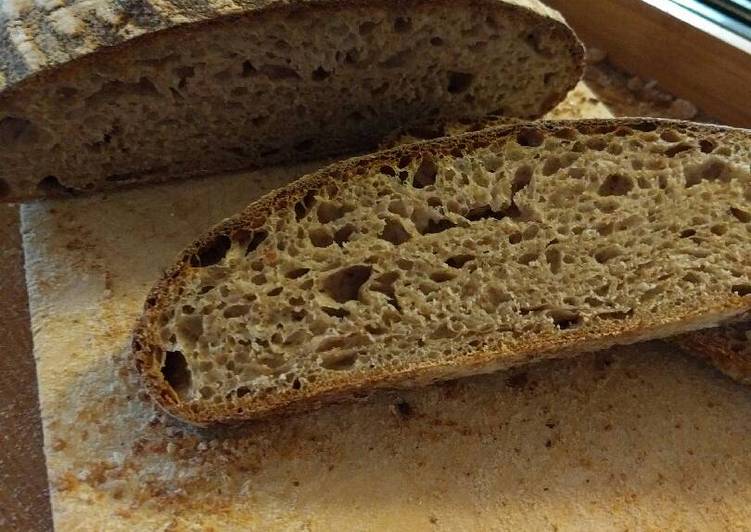Recipe: Delightful Slow Fermented (non Retarded) Wholemeal Sourdough
Slow fermented (non retarded) wholemeal sourdough. Slow fermented whole spelt sourdough bread. Let me say right from the start that I am not a measuring kinda guy when it comes to my bread. Add ½ cup of water, ½ cup of wholemeal spelt flour, stir well, cover with muslin (or similar), and leave in a.
 For sourdoughs, I have not yet tried anything longer than overnight retard in the fridge. Has any of you retarded sourdoughs longer than this? Organic Flour vs Non-Organic Flour for Sourdough Bread. You possibly can cook Slow fermented (non retarded) wholemeal sourdough using 5 ingredients and 18 steps. Right here is the planning you have to do cooking it.
For sourdoughs, I have not yet tried anything longer than overnight retard in the fridge. Has any of you retarded sourdoughs longer than this? Organic Flour vs Non-Organic Flour for Sourdough Bread. You possibly can cook Slow fermented (non retarded) wholemeal sourdough using 5 ingredients and 18 steps. Right here is the planning you have to do cooking it.
Ingredients of Slow fermented (non retarded) wholemeal sourdough
- – It’s 150 g of sourdough starter.
- – You need 200 g of very strong white flour.
- – You need 385 g of strong wholemeal flour.
- – You need 420 ml of cold water.
- – It’s 14 g of salt.
When it comes to sourdough bread, we Non-organic flours are often bleached, which means they are chemically treated to whiten and age The more wholemeal you have in your sourdough, the more dense it will be, but the more flavor it. Generally with sourdough after the bulk ferment (before shaping) you don't "knock back" – that's just taking out all the air and hoping there's enough Some of our sourdoughs we will make to cover two days of bakes. Same process as before but instead of letting the sourdoughs proof up a little bit we. All it takes to make it look really attractive is a couple of slashes after the proofing stage.
Slow fermented (non retarded) wholemeal sourdough instructions
- Mix together the starter and the flours, with almost all of the water (hold back a couple of spoonfuls).
- Leave to autolyse for 30 mins..
- Mix the salt with the remaining water..
- Distribute the salty water evenly over the dough.
- Using a stand mixer with a dough hook (on a low speed) or by hand – knead very well for 15-20 minutes until dough is very strong and well developed.
- Cover the bowl and leave to rise for 24 hours at (cool) room temperature.
- Divide dough in two and pre-shape on a lightly floured surface.
- I now like to freeze one half – tightly wrapped in clingfilm.
- After a 5-10 minute rest, tightly shape the dough and place in a proving basket or tin.
- Leave to rise for another 18-24 hours until doubled in size / full of gas.
- Preheat oven to 240°C for 30 mins.
- Turn out dough onto your baking surface and slash with an oiled razor blade.
- Throw a half cup of water into the bottom of the oven.
- Add the dough and turn down heat to 210°C.
- Bake for 20 mins and reduce heat to 200°C.
- Bake for a futher 20 mins..
- If crust still needs to be darker then turn off oven and leave bread inside for 10-15 mins.
- Cool, then eat.
The joy of sourdough bread baking for me lies in the slow development over time… a true pleasure each step of the way. Natural yeasts provide leavening in long-fermented sourdough. You'll spend less time working your dough and more time letting the sourdough do the work for These more traditional recipes work well when you do not need to bake right away or want to enjoy the other benefits of fermented sourdough Wholemeal bread baked in a slow cooker. The shaped loaf goes straight into the slow cooker after the bulk ferment period, hence eliminating the need for a second proof. Assumes the viewer has a sourdough/starter.
Last but not least, take pleasure in the food item from your recipe above. You could acquire a few creations to match your taste because each tastes are wide and varied and furthermore,as which causes cooking more enjoyable. Do not forget to try our other recipes.
Source : Cookpad.com